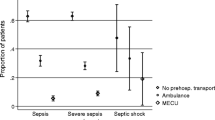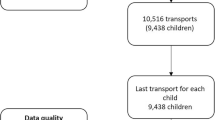Abstract
Background
With the unequal distribution of medical resources in developing countries, critically ill children need to be transferred to tertiary hospitals from primary hospitals with limited resources. Although a large number of critically ill children are transferred each day in China, the standard process of inter-hospital transport is not formulated.
Methods
We retrospectively analyzed the data collected during transport. A total number of 9231 patients (≤14 years) who had been transferred to the Hunan Children’s Hospital by a specialized team from primary hospitals from January 1, 2009 to June 30, 2012 were included in the study.
Results
Nearly half of the critically ill children were neonates (48.72%) and two thirds of the children were suffering from respiratory, neurological and cardiac diseases. Multivariate adjusted odds ratios (OR) and 95% confidence intervals (CI) were calculated using unconditional logistic regression. Mobilization time in non-working hours was longer than the working hours (OR=1.186, 95% CI=1.059–1.329). Our study showed that mobilization time for neonates was shorter than that for older children (OR=0.801, 95% CI=0.692–0.928). The mobilization time of referral cases was shorter in areas within a radius of 50 km than in those within a radius of over 250 km (OR=0.427, 95% CI=0.350–0.521). Referred patients in summer needed a significantly shorter mobilization time than in winter (OR=0.705, 95% CI=0.616–0.806).
Conclusion
Standardized processes and guidelines for inter-hospital transport would be essential to ensure effective transport of patients and reduce the mobilization activation time.
Similar content being viewed by others
References
Petrillo-Albarano T, Stockwell J, Leong T, Hebbar K. The use of a modified pediatric early warning score to assess stability of pediatric patients during transport. Pediatr Emerg Care 2012;28:878–882.
Ramnarayan P, Thiru K, Parslow RC, Harrison DA, Draper ES, Rowan KM. Effect of specialist retrieval teams on outcomes in children admitted to paediatric intensive care units in England and Wales: a retrospective cohort study. Lancet 2010;376:698–704.
Borrows EL, Lutman DH, Montgomery MA, Petros AJ, Ramnarayan P. Effect of patient- and team-related factors on stabilization time during pediatric intensive care transport. Pediatr Crit Care Med 2010;11:451–456.
Pollack MM, Alexander SR, Clarke N, Ruttimann UE, Tesselaar HM, Bachulis AC. Improved outcomes from tertiary center pediatric intensive care: a statewide comparison of tertiary and nontertiary care facilities. Crit Care Med 1991;19:150–159.
Dudley RA, Johansen KL, Brand R, Rennie DJ, Milstein A. Selective referral to high-volume hospitals: estimating potentially avoidable deaths. JAMA 2000;283:1159–1166.
Vos GD, Nissen AC, Nieman FH, Meurs MM, van Waardenburg DA, Ramsay G, et al. Comparison of interhospital pediatric intensive care transport accompanied by a referring specialist or a specialist retrieval team. Intensive Care Med 2004;30:302–308.
Orr RA, Felmet KA, Han Y, McCloskey KA, Dragotta MA, Bills DM, et al. Pediatric specialized transport teams are associated with improved outcomes. Pediatrics 2009;124:40–48.
Edge WE, Kanter RK, Weigle CG, Walsh RF. Reduction of morbidity in interhospital transport by specialized pediatric staff. Crit Care Med 1994;22:1186–1191.
White M, Weir PM, Garland L, Edees S, Henderson AJ. Outcome of critically ill children before and after the establishment of a pediatric retrieval service as a component of a national strategy for pediatric intensive care. Pediatr Crit Care Med 2002;3:255–260.
Institute of Medicine of the National Academies. Emergency Care for Children:Growing Pains.Washington, DC: National Academies Press, 2007: 2–3.
Abdel-Latif ME, Berry A. Analysis of the retrieval times of a centralised transport service, New South Wales, Australia. Arch Dis Child 2009;94:282–286.
Ramnarayan P. Measuring the performance of an inter-hospital transport service. Arch Dis Child 2009;94:414–416.
Britto J, Nadel S, Maconochie I, Levin M, Habibi P. Morbidity and severity of illness during interhospital transfer: impact of a specialised paediatric retrieval team. BMJ 1995;311:836–839.
Berry A. Emergency medical transport and retrieval. In: Cameron P, Jelinek G, Everitt I. Textbook of paediatric emergency medicine, 1st edn. Oxford: Churchill Livingstone, 2006: 679–681.
Philpot C, Day S, Marcdante K, Gorelick M. Pediatric interhospital transport: diagnostic discordance and hospital mortality. Pediatr Crit Care Med 2008;9:15–19.
Warren J, Fromm RJ, Orr RA, Rotello LC, Horst HM. Guidelines for the inter- and intrahospital transport of critically ill patients. Crit Care Med 2004;32:256–262.
White M, Weir PM, Garland L, Edees S, Henderson AJ. Outcome of critically ill children before and after the establishment of a pediatric retrieval service as a component of a national strategy for pediatric intensive care. Pediatr Crit Care Med 2002;3:255–260.
Jouvet P, Lacroix J. Improving interhospital paediatric transport. Lancet 2010;376:660–661.
Kempley ST, Baki Y, Hayter G, Ratnavel N, Cavazzoni E, Reyes T. Effect of a centralised transfer service on characteristics of inter-hospital neonatal transfers. Arch Dis Child Fetal Neonatal Ed 2007;92:F185–F188.
Beddingfield FR, Garrison HG, Manning JE, Lewis RJ. Factors associated with prolongation of transport times of emergency pediatric patients requiring transfer to a tertiary care center. Pediatr Emerg Care 1996;12:416–419.
Selig HF, Trimmel H, Voelckel WG, Hupfl M, Trittenwein G, Nagele P. Prehospital pediatric emergencies in Austrian helicopter emergency medical service — a nationwide, populationbased cohort study. Wien Klin Wochenschr 2011;123:552–558.
Stroud MH, Prodhan P, Moss MM, Anand KJ. Redefining the golden hour in pediatric transport. Pediatr Crit Care Med 2008;9:435–437.
Baez AA, Lane PL, Sorondo B, Giraldez EM. Predictive effect of out-of-hospital time in outcomes of severely injured young adult and elderly patients. Prehosp Disaster Med 2006;21:427–430.
de Oliveira CF, de Oliveira DS, Gottschald AF, Moura JD, Costa GA, Ventura AC, et al. ACCM/PALS haemodynamic support guidelines for paediatric septic shock: an outcomes comparison with and without monitoring central venous oxygen saturation. Intensive Care Med 2008;34:1065–1075.
Mazzola CA, Adelson PD. Critical care management of head trauma in children. Crit Care Med 2002;30:S393–S401.
Rivers E, Nguyen B, Havstad S, Ressler J, Muzzin A, Knoblich B, et al. Early goal-directed therapy in the treatment of severe sepsis and septic shock. N Engl J Med 2001;345:1368–1377.
Pollack MM, Patel KM, Ruttimann UE. PRISM III: an updated Pediatric Risk of Mortality score. Crit Care Med 1996;24:743–752.
Pollack MM, Ruttimann UE, Getson PR. Pediatric risk of mortality (PRISM) score. Crit Care Med 1988;16:1110–1116.
Slater A, Shann F, Pearson G. PIM2: a revised version of the Paediatric Index of Mortality. Intensive Care Med 2003;29:278–285.
Shann F, Pearson G, Slater A, Wilkinson K. Paediatric index of mortality (PIM): a mortality prediction model for children in intensive care. Intensive Care Med 1997;23:201–207.
Author information
Authors and Affiliations
Corresponding author
Rights and permissions
About this article
Cite this article
Qiu, J., Wu, XL., Xiao, ZH. et al. Investigation of the status of interhospital transport of critically ill pediatric patients. World J Pediatr 11, 67–73 (2015). https://doi.org/10.1007/s12519-015-0004-8
Received:
Accepted:
Published:
Issue Date:
DOI: https://doi.org/10.1007/s12519-015-0004-8




